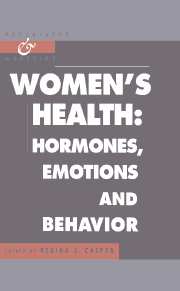Book contents
- Frontmatter
- Contents
- Preface
- 1 Growing up female
- 2 Reproduction and its psychopathology
- 3 Women's sexual function and dysfunction
- 4 Gender differences in brain morphology and in psychiatric disorders
- 5 Thyroid hormones in major depressive disorder and bipolar disorder
- 6 The hypothalamic-pituitary-adrenocortical system
- 7 The cost of starvation: Eating disorders
- 8 Coronary artery disease and women: Estrogens and psychosocial and lifestyle risk factors
- 9 The psychophysiology of breast cancer: Disease, hormones, immunity, and stress
- 10 The psychopharmacology of women
- 11 Intervention trials concerned with disease prevention in women
- References
- Index
10 - The psychopharmacology of women
Published online by Cambridge University Press: 08 February 2010
- Frontmatter
- Contents
- Preface
- 1 Growing up female
- 2 Reproduction and its psychopathology
- 3 Women's sexual function and dysfunction
- 4 Gender differences in brain morphology and in psychiatric disorders
- 5 Thyroid hormones in major depressive disorder and bipolar disorder
- 6 The hypothalamic-pituitary-adrenocortical system
- 7 The cost of starvation: Eating disorders
- 8 Coronary artery disease and women: Estrogens and psychosocial and lifestyle risk factors
- 9 The psychophysiology of breast cancer: Disease, hormones, immunity, and stress
- 10 The psychopharmacology of women
- 11 Intervention trials concerned with disease prevention in women
- References
- Index
Summary
Women are the principal recipients and have been shown to be the major “consumers” of drugs (Cafferata, Kasper, and Bernstein, 1983; Dworkin and Adams, 1984). By contrast, drug toxicity studies have almost exclusively used male rats as experimental animals (Kato and Yamazoe, 1992), and drug efficacy and safety trials typically have been conducted in men. Not until 1993 did the Food and Drug Administration (FDA) drop its mandate that women be excluded from drug trials. Of course, utmost precautions must be taken to avoid exposing pregnant women to investigational drugs. The decision by the FDA came at a time when other changes in drug development, for instance, in chirotechnology, impacted drug efficacy and safety studies. Because nearly half the organic compounds on the market as drugs consist of isomers (i.e., they contain the dextro- or levorotating forms of the same molecule – for example, the L form of limonene gives lemons their taste, whereas the D form flavors oranges) and because the two forms almost always differ in their action or pharmacologic activity, the FDA began in 1992 to require information about both isomers of a drug. Studies into gender or age effects of racemic compounds are in the initial phases (Hooper and Qing, 1990). Some evidence for subtle sex differences in enantiomer protein binding has emerged (Gilmore et al., 1992).
To produce its pharmacologic effects, a drug must be present in sufficient concentration at its site(s) of action. Ideally, one wants to reach the sites that mediate therapeutic efficacy without immersing peripheral and central neuronal receptors in a sea of drug molecules.
Keywords
- Type
- Chapter
- Information
- Women's HealthHormones, Emotions and Behavior, pp. 192 - 218Publisher: Cambridge University PressPrint publication year: 1997



